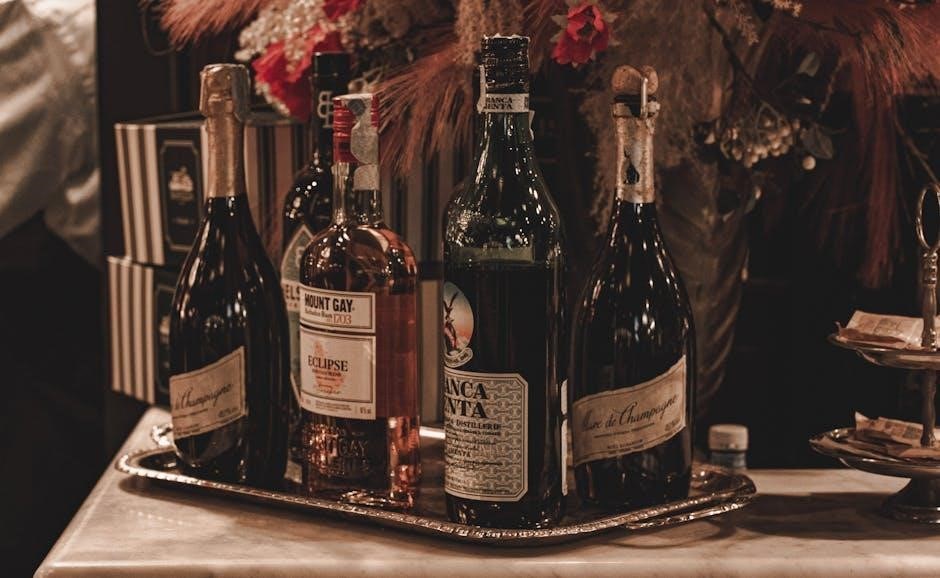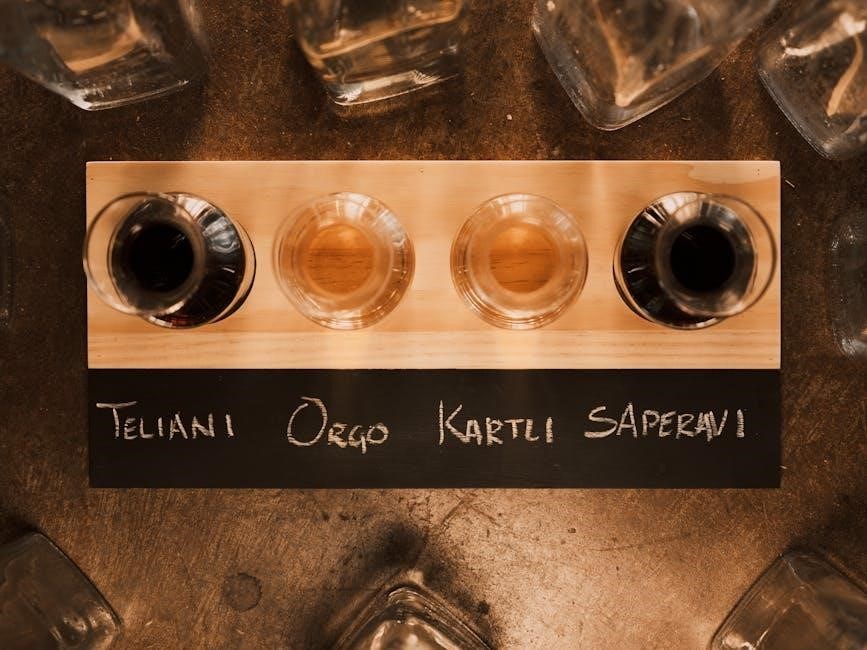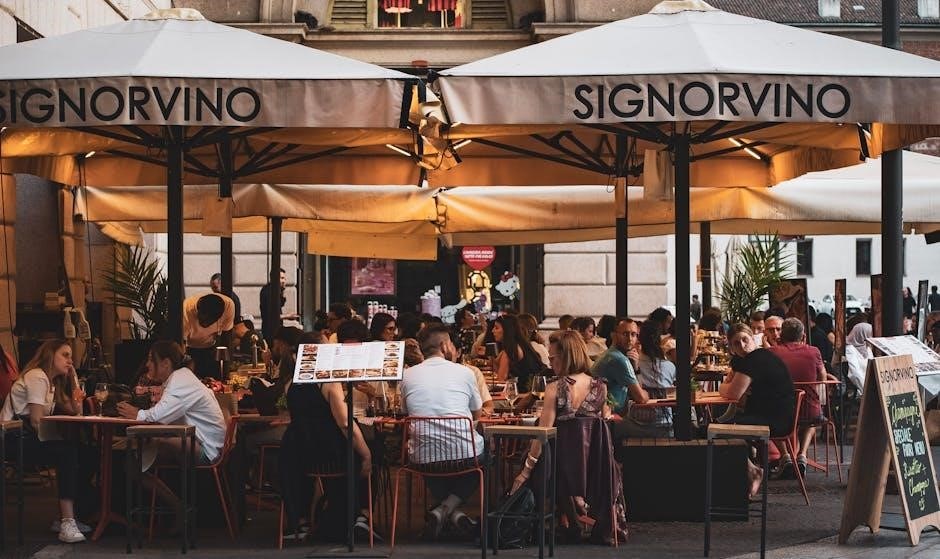wine name list a to z pdf

An A-to-Z wine list offers a structured, user-friendly guide to explore wines alphabetically, featuring detailed descriptions, origins, and tasting notes for seamless navigation and discovery.
1.1. Understanding the Importance of Wine Lists
A well-crafted wine list is essential for enhancing dining experiences and simplifying wine selection. It provides a comprehensive overview of available wines, organized by type or region, with details like origin, price, and flavor profiles. This structure helps diners navigate effortlessly, while sommeliers and staff use it to guide recommendations. A thoughtfully curated list also reflects the establishment’s commitment to quality and diversity, catering to both novice drinkers and connoisseurs. Ultimately, it bridges the gap between the vineyard and the table, fostering appreciation and exploration of wines from around the world.
1.2. Benefits of an A-to-Z Wine List
An A-to-Z wine list simplifies wine selection by organizing varieties alphabetically, making it easier for diners to locate specific wines. This format encourages exploration of diverse options, from rare vintages to popular favorites like Chardonnay or Syrah/Shiraz. It also aids in pairing wines with food, as descriptions often highlight flavor profiles. For restaurants, an A-to-Z list enhances customer satisfaction and streamlines staff recommendations. Its clarity and accessibility make it a valuable tool for both novices and connoisseurs, fostering a deeper appreciation for global wines.

Sparkling Wines
Sparkling wines, such as Champagne, Prosecco, and Moscato, are celebrated for their effervescence and festive appeal. These wines offer a diverse range of styles, from crisp to sweet.
2.1. Champagne
Champagne, originating from France’s Champagne region, is renowned for its effervescence and luxurious appeal. Produced using the traditional méthode champenoise, it offers a range of styles, from Brut to Rosé. Made primarily from Chardonnay, Pinot Noir, and Pinot Meunier, Champagne is celebrated for its complexity and finesse. Popular Champagne houses include Dom Pérignon, Krug, and Bollinger, each offering unique flavor profiles. Whether for celebrations or special occasions, Champagne remains a timeless choice, embodying elegance and sophistication in every sip.
2.2. Prosecco
Prosecco, a popular Italian sparkling wine, is made from Glera grapes and offers a crisp, fruity profile. Known for its floral and peach notes, it’s a budget-friendly alternative to Champagne. Perfect for celebrations, Prosecco pairs well with seafood or as a base for Bellinis. Its effortless charm and versatility make it a favorite in many wine lists globally.
2.3. Other Sparkling Wines
Beyond Champagne and Prosecco, the world of sparkling wines offers diverse options. Cava from Spain, made using traditional methods, is known for its crisp acidity and affordability. Sekt, Germany’s sparkling wine, often features Riesling grapes, offering floral and fruity notes. Other varieties include Franciacorta from Italy and New World sparklers like those from California. These wines showcase unique regional styles, blending tradition with innovation, and are gaining recognition for their quality and versatility in global wine lists.

White Wines
White wines offer a diverse range of flavors, from the crisp, zesty notes of Sauvignon Blanc to the rich, buttery profiles of Chardonnay. Varieties like Pinot Grigio, Gewürztraminer, and Riesling provide a spectrum of floral, fruity, and mineral notes, catering to various palates. Their versatility pairs well with seafood, poultry, or as an aperitif, making them a cornerstone in any wine collection.
3.1. Chardonnay
Chardonnay is one of the world’s most popular white wines, known for its rich, buttery, and oaky flavors. Aged in oak barrels, it develops a smooth, creamy texture with notes of vanilla, caramel, and hints of citrus. Chardonnay pairs perfectly with seafood, roasted chicken, and creamy sauces, making it a versatile choice for various culinary pairings. Its adaptability to different regions and winemaking styles ensures a wide range of expressions, from crisp and minerally to full-bodied and complex.
3.2. Sauvignon Blanc
Sauvignon Blanc is a crisp and refreshing white wine, celebrated for its citrus, green apple, and grassy notes. Its vibrant acidity makes it a popular choice, offering a zesty and clean finish. Originating from regions like Marlborough, New Zealand, and the Loire Valley in France, it pairs well with lighter dishes such as salads, seafood, and goat cheese. Its distinct aroma and flavor profile make it a favorite for those seeking a revitalizing and aromatic wine experience.
3.3. Pinot Grigio
Pinot Grigio is a light, crisp white wine known for its refreshing citrus and floral notes. Originating from Italy, it offers flavors of lemon, lime, and subtle honeydew, with a clean, zesty finish. Its versatility pairs well with seafood, salads, and light pasta dishes. Grown in regions like Friuli-Venezia Giulia and Oregon, Pinot Grigio is celebrated for its easy-drinking style and delicate acidity, making it a popular choice for casual gatherings and everyday enjoyment.

Red Wines
Red wines offer a diverse range of flavors, from light-bodied Pinot Noir to bold Cabernet Sauvignon and Merlot, showcasing rich tannins, fruity notes, and earthy undertones, perfect for pairing with hearty dishes.
4;1. Cabernet Sauvignon
Cabernet Sauvignon is a full-bodied red wine known for its dark fruit flavors, spice, and high tannins. Popular in regions like Bordeaux and Napa Valley, it pairs well with red meats and aged cheeses, offering a robust and complex profile. Its adaptability to various climates makes it a favorite among winemakers. Aging enhances its structure, revealing hints of vanilla and oak. A classic choice for special occasions, Cabernet Sauvignon is celebrated for its bold character and longevity.
4.2. Merlot
Merlot is a smooth, approachable red wine with flavors of plum, blackberry, and chocolate. Known for its soft tannins, it is a great introduction to red wines. Grown globally, Merlot thrives in regions like Bordeaux, Tuscany, and Napa Valley. It pairs well with pasta, grilled meats, and robust cheeses. Merlot is often blended with Cabernet Sauvignon for added complexity. Its versatility and drinkability make it a popular choice for both casual sipping and special occasions, offering quality and value in every sip.
4.3. Syrah/Shiraz
Syrah/Shiraz is a full-bodied red wine known for its dark fruit flavors, peppery spice, and smooth tannins. Originating from the Rhone Valley in France, it is also prominent in Australia. The wine often features notes of blackberry, black pepper, and sometimes smoky undertones. Syrah/Shiraz pairs well with red meats, game, and robust cheeses. Its bold character makes it a favorite for those who enjoy rich, savory wines; Age-worthy and versatile, it offers deep complexity and satisfaction for red wine enthusiasts seeking a hearty experience.

Rosé Wines
Rosé wines offer a refreshing, elegant experience with delicate flavors of strawberry, citrus, and floral notes, perfect for summer. Popular varieties include Provence Rosé and Italian Rosé.
5.1. Provence Rosé
Provence Rosé, originating from France’s Provence region, is renowned for its delicate, dry style and pale pink hue. These wines typically feature crisp acidity and subtle flavors of citrus, strawberry, and floral notes, making them ideal for pairing with Mediterranean cuisine. Their light, refreshing profile has contributed to their global popularity, especially during summer. Provence Rosé is often described as elegant and versatile, suitable for casual sipping or accompanying dishes like seafood, salads, or grilled vegetables.
5.2. Italian Rosé
Italian Rosé, or Rosato, offers a vibrant and refreshing profile, often showcasing bright acidity and moderate tannins. Hailing from regions like Tuscany and Veneto, these wines are crafted from grapes such as Sangiovese and Corvina. Flavors typically include strawberry, cherry, and floral notes, with a crisp, clean finish. Italian Rosé pairs beautifully with Mediterranean dishes, antipasto, or pasta, making it a versatile choice for casual gatherings or formal meals. Its elegant yet approachable style has made it a favorite among wine enthusiasts worldwide.

Dessert and Fortified Wines
Dessert and fortified wines are sweet, rich, and often aged, offering complex flavors. Examples include Sauternes, Port, and Sherry, perfect for pairing with desserts or cheeses.
6.1. Port Wine
Port Wine, a fortified wine from Portugal, is renowned for its rich, sweet flavors and velvety texture. Produced primarily from grapes like Touriga Nacional and Tinta Roriz, it undergoes a unique fermentation process; The addition of neutral grape spirit stops fermentation, preserving natural sugars. Aged for years, Port develops complex notes of dried fruits, chocolate, and nuts. Popular styles include Ruby, Tawny, and Vintage. Perfect for desserts or cheese pairings, Port Wine offers a luxurious and indulgent experience, with iconic brands like Taylor Fladgate and Graham’s leading the market.
6.2. Sherry
Sherry, a fortified wine from Spain’s Jerez region, offers a diverse range of styles, from dry to sweet. Produced using the solera system, Sherry’s unique aging process creates distinct profiles. Fino and Manzanilla are light and crisp, while Amontillado and Oloroso are richer, with nutty flavors. Pedro Ximénez (PX) is sweet and fruity, ideal for desserts. Sherry pairs beautifully with tapas, cheeses, and chocolates, making it a versatile choice. Popular brands like Gonzalez Byass and Lustau showcase Sherry’s elegance and complexity, offering something for every palate in wine lists worldwide.
6.3. Sauternes
Sauternes, a luxurious dessert wine from Bordeaux, France, is renowned for its sweet, complex profile. Produced from Sémillon, Sauvignon Blanc, and Muscadelle grapes affected by botrytis cinerea, Sauternes offers a rich, golden nectar with flavors of honey, dried fruits, and caramel. Its luscious texture and balanced acidity make it a perfect pairing for foie gras, blue cheeses, and sweet delicacies; Iconic châteaux like Château d’Yquem and Château Rieussec exemplify Sauternes’ elegance, while its aging potential ensures it remains a treasured choice for wine enthusiasts and connoisseurs alike.
Regional Wine Guides
Explore wines from renowned regions like Italy, France, and New World areas, featuring iconic varieties and styles that highlight each area’s unique winemaking traditions and excellence.
7.1. Italian Wines
Italy, the world’s largest wine producer, offers a vast array of wines from regions like Tuscany, Piedmont, and Veneto. Iconic reds include Chianti, Barolo, and Amarone, while whites like Pinot Grigio and Moscato d’Asti showcase diversity. Italian wines are celebrated for their complexity and regional uniqueness, reflecting centuries of winemaking tradition and innovation. From bold, full-bodied reds to crisp, refreshing whites, Italy’s wine portfolio is a testament to its rich viticultural heritage and global influence in the world of wine.
7.2. French Wines
French wines are renowned for their elegance and diversity, with regions like Bordeaux, Burgundy, Champagne, and the Loire Valley producing iconic varieties. Bordeaux is famous for its bold red blends of Cabernet Sauvignon and Merlot, while Burgundy excels with Pinot Noir and Chardonnay. Champagne stands out for its luxurious sparkling wines, and the Loire Valley offers crisp whites like Sauvignon Blanc. French wines are celebrated for their terroir-driven complexity and pair beautifully with various cuisines, making them a cornerstone of any wine list.
7.3. New World Wines
New World Wines, originating from regions like the Americas, Australia, and New Zealand, are celebrated for their bold flavors and innovative winemaking techniques. Countries such as the United States, Argentina, and Chile produce standout varieties like Cabernet Sauvignon, Malbec, and Sauvignon Blanc. Napa Valley in California is renowned for its full-bodied reds, while Marlborough in New Zealand is famous for its crisp Sauvignon Blanc. These wines are often described as fruit-forward and approachable, making them a popular choice for modern wine enthusiasts.

Popular Wine Names A-to-Z
An A-to-Z wine list provides a comprehensive guide, showcasing popular wines alphabetically. This user-friendly format allows easy exploration of diverse varieties, regions, and styles, enhancing wine discovery for enthusiasts.
8.1. A-Z List of Red Wines
A comprehensive A-to-Z list of red wines offers a diverse exploration of global varieties. From rich, full-bodied Cabernet Sauvignon to elegant Pinot Noir, and robust Syrah/Shiraz, each wine showcases unique regional characteristics. Discover popular options like Malbec, known for plum and spice notes, and Zinfandel, with its bold fruit flavors. The list also includes lesser-known gems, such as Aglianico and Tempranillo, highlighting the complexity and variety of red wines from around the world. This guide simplifies the journey through the vast world of red wines.
8.2. A-Z List of White Wines
An A-to-Z list of white wines presents a vast array of options, from crisp Sauvignon Blanc to buttery Chardonnay. Pinot Grigio offers citrus notes, while Riesling ranges from sweet to dry. Gewürztraminer and Moscato provide aromatic and fruity profiles. Albariño and Chenin Blanc add minerality and complexity. This guide simplifies exploring white wines, highlighting their diverse styles, regions, and flavor profiles, making it easier to discover new favorites or pair with specific dishes.
8.3. A-Z List of Sparkling Wines
A comprehensive A-to-Z list of sparkling wines showcases iconic varieties like Champagne, Prosecco, and Cava, alongside lesser-known gems such as Sekt and Franciacorta. Champagne, hailing from France, offers complex, toasty notes, while Prosecco from Italy delivers fruity and floral aromas. Cava, Spain’s contribution, provides crisp acidity and versatility. Other highlights include Moscato d’Asti for sweetness and Crémant for regional French diversity. This guide simplifies discovering sparkling wines, offering pairing ideas and flavor profiles for every occasion, from celebrations to casual gatherings.

Wine and Food Pairing Guide
This guide helps you discover perfect pairings for every wine, from sparkling to dessert, ensuring harmony between flavors and cuisines for a delightful culinary journey.
9.1. Pairing Red Wines with Food
Red wines, known for their bold flavors, pair exceptionally well with hearty dishes. Cabernet Sauvignon complements grilled meats and robust cheeses, while Merlot pairs nicely with pasta and lean proteins. Syrah/Shiraz, with its spicy notes, matches well with game meats and rich stews. Lighter reds like Pinot Noir are ideal for delicate flavors, such as salmon or earthy mushrooms. Balancing tannins and acidity ensures harmonious pairings, enhancing both the wine and the meal for a memorable dining experience.
9.2. Pairing White Wines with Food
White wines are versatile and complement a variety of dishes. Chardonnay pairs well with rich seafood, roasted chicken, and creamy sauces, while Sauvignon Blanc excels with citrusy salads, fresh herbs, and goat cheese. Pinot Grigio complements lighter fare like seafood, pasta, and vegetables due to its crisp acidity. Riesling, with its sweetness, is ideal for spicy dishes or sweet-and-savory combinations. Pairing white wines thoughtfully enhances both the meal and the wine, offering a balanced and enjoyable dining experience for any palate.
9.3. Pairing Sparkling Wines with Food
Sparkling wines like Champagne and Prosecco are versatile and enhance various dishes. Champagne pairs elegantly with caviar, seafood, and rich sauces, while Prosecco complements lighter fare such as fruit, cheese, and appetizers. Their effervescence cuts through fatty or sweet flavors, making them ideal for desserts like chocolate or fruit tarts. Sparkling wines also pair well with savory dishes like roasted poultry or charcuterie. Their acidity and bubbles refresh the palate, creating a harmonious balance between the wine and the meal, perfect for celebrations or casual gatherings.

How to Navigate an A-to-Z Wine List
Mastering an A-to-Z wine list involves understanding its organization by region, grape variety, and style. This structure helps identify preferences and discover new wines efficiently.
10.1. Tips for Selecting Wine from a List
When selecting wine from an A-to-Z list, start by identifying your preferences, such as red, white, or sparkling. Consider the occasion and any food pairings. Look for wines from renowned regions like Italy or France, which often offer high-quality options. Familiarize yourself with grape varieties, as they can guide your choice. Don’t hesitate to ask for recommendations, and explore regional specialties to discover new favorites. This structured approach ensures a seamless and enjoyable experience.
10.2. Understanding Wine Descriptions
Wine descriptions in an A-to-Z list typically include the wine’s name, origin, and price, along with brief notes on aromas and flavors. These descriptions help consumers make informed choices by highlighting key characteristics, such as whether a wine is crisp, fruity, or full-bodied. Pay attention to terms like “oaky” or “citrus notes” to gauge flavor profiles. Understanding these descriptions allows you to match wines with your preferences or pair them with specific dishes, enhancing your overall dining experience.

Wine Tasting and Appreciation
Wine tasting combines the art and science of evaluating wines, focusing on aroma, flavor, and finish. It enhances appreciation by exploring diverse styles and grape varieties.
11.1. Basic Wine Tasting Techniques
Mastering basic wine tasting involves observing appearance, aroma, and palate. Hold the glass to assess clarity and color. Swirl to release aromas, noting bouquet and nose. Taste, evaluating acidity, tannins, body, and finish. This structured approach enhances understanding of wine complexity and quality, aiding in identifying grape varieties and regional styles. Proper techniques ensure a comprehensive sensory experience, making wine appreciation more enjoyable and informed.
11.2; Wine Aroma and Flavor Profiles
Wine aroma and flavor profiles are shaped by grape variety, terroir, and winemaking techniques. Aromas can range from floral to fruity, while flavors may include notes of citrus, spice, or earth. For example, Chardonnay often exhibits buttery and vanilla notes, while Sauvignon Blanc is known for its citrus and grassy undertones. Understanding these profiles helps in identifying wines and pairing them with complementary dishes, enhancing the overall culinary experience and deepening appreciation for wine diversity and complexity.
Exploring wines through an A-to-Z list reveals a world of diversity, from renowned varieties to hidden gems, inspiring enthusiasts to continue their journey of discovery and appreciation.
12.1. Final Thoughts on Exploring Wines
Exploring wines through an A-to-Z list offers a comprehensive journey, from discovering hidden gems to appreciating renowned varieties. This organized approach simplifies the process, catering to both beginners and connoisseurs. By providing detailed descriptions, origins, and tasting notes, it fosters a deeper understanding of grape varieties and regions. Whether savoring a rich Amarone or a sweet Moscato, the diversity of wines ensures endless exploration. Embrace the adventure, as each bottle tells a story, inviting you to uncover new flavors and broaden your palate.
12.2. Encouragement to Continue Wine Exploration
Embrace the world of wine with curiosity and enthusiasm, as every bottle offers a unique experience. From the crisp notes of Sauvignon Blanc to the rich complexity of Amarone, exploration broadens your palate and deepens your appreciation. Whether you’re a novice or a seasoned connoisseur, the journey of discovery is endlessly rewarding. Keep exploring, learning, and savoring the diverse flavors and stories behind each wine. Let your adventures guide you to new favorites and unforgettable moments of delight.
Leave a Reply
You must be logged in to post a comment.